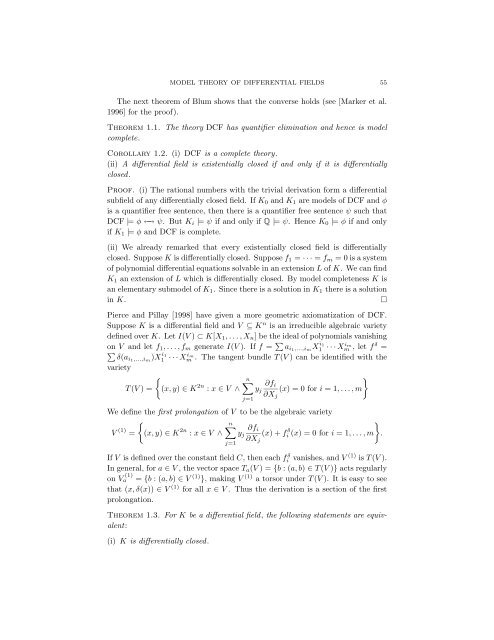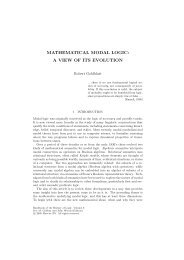Model Theory of Differential Fields
Model Theory of Differential Fields
Model Theory of Differential Fields
Create successful ePaper yourself
Turn your PDF publications into a flip-book with our unique Google optimized e-Paper software.
MODEL THEORY OF DIFFERENTIAL FIELDS 55The next theorem <strong>of</strong> Blum shows that the converse holds (see [Marker et al.1996] for the pro<strong>of</strong>).Theorem 1.1. The theory DCF has quantifier elimination and hence is modelcomplete.Corollary 1.2. (i) DCF is a complete theory.(ii) A differential field is existentially closed if and only if it is differentiallyclosed.Pro<strong>of</strong>. (i) The rational numbers with the trivial derivation form a differentialsubfield <strong>of</strong> any differentially closed field. If K 0 and K 1 are models <strong>of</strong> DCF and φis a quantifier free sentence, then there is a quantifier free sentence ψ such thatDCF |= φ ←→ ψ. But K i |= ψ if and only if Q |= ψ. Hence K 0 |= φ if and onlyif K 1 |= φ and DCF is complete.(ii) We already remarked that every existentially closed field is differentiallyclosed. Suppose K is differentially closed. Suppose f 1 = · · · = f m = 0 is a system<strong>of</strong> polynomial differential equations solvable in an extension L <strong>of</strong> K. We can findK 1 an extension <strong>of</strong> L which is differentially closed. By model completeness K isan elementary submodel <strong>of</strong> K 1 . Since there is a solution in K 1 there is a solutionin K.□Pierce and Pillay [1998] have given a more geometric axiomatization <strong>of</strong> DCF.Suppose K is a differential field and V ⊆ K n is an irreducible algebraic varietydefined over K. Let I(V ) ⊂ K[X 1 , . . . , X n ] be the ideal <strong>of</strong> polynomials vanishingon V and let f 1 , . . . , f m generate I(V ). If f = ∑ a i1,...,i mX i11 · · · Xim m , let f δ =∑δ(ai1,...,i m)X i11 · · · Xim m . The tangent bundle T (V ) can be identified with thevarietyT (V ) ={(x, y) ∈ K 2n : x ∈ V ∧n∑j=1}∂f iy j (x) = 0 for i = 1, . . . , m∂X jWe define the first prolongation <strong>of</strong> V to be the algebraic variety{}n∑V (1) = (x, y) ∈ K 2n ∂f i: x ∈ V ∧ y j (x) + fi δ (x) = 0 for i = 1, . . . , m .∂X jj=1If V is defined over the constant field C, then each fi δ vanishes, and V (1) is T (V ).In general, for a ∈ V , the vector space T a (V ) = {b : (a, b) ∈ T (V )} acts regularlyon V a(1) = {b : (a, b) ∈ V (1) }, making V (1) a torsor under T (V ). It is easy to seethat (x, δ(x)) ∈ V (1) for all x ∈ V . Thus the derivation is a section <strong>of</strong> the firstprolongation.Theorem 1.3. For K be a differential field, the following statements are equivalent:(i) K is differentially closed.
















